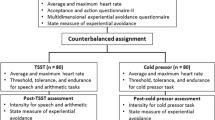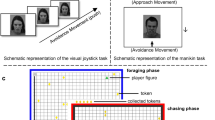Abstract
The degree to which experiential avoidance may represent a functional response class was examined by comparing the perseverance of participants displaying high versus low levels of experiential avoidance, as assessed by the Acceptance and Action Questionnaire (Hayes et al., 2004), during a “psychological biathlon” consisting of 2 challenging tasks that previously had only been studied separately. Consistent with previous research, high avoidant participants were less tolerant of pain and were outperformed by low avoidant participants during a distress-inducing perceptual–motor task. The 2 groups of participants also differed significantly from each other on a composite perseverance measure derived from standard scores on each of the separate tasks, suggesting that experiential avoidance operates as a functional response class. We discuss implications of the findings for the assessment, further investigation, and conceptualization of experiential avoidance as a core process that supports diverse forms of human suffering and dysfunctional behavior.
Similar content being viewed by others
References
AMERICAN PSYCHOLOGICAL ASSOCIATION. (2002). ethical principles of psychologists and code of conduct. American Psychologist, 57, 1060–1073. doi: 10.1037/0003-066X.57.12.1060
BARRETT, B. H., JOHNSTON, J. M., & PENNYPACKER, H. S. (1986). Behavior: Its units, dimensions, and measurement. In R. O. Nelson & S. C. Hayes (eds.), Conceptual foundations of behavioral assessment (pp. 156–200). New York, NY: Guilford.
BERNSTEIN, E., & PUTNAM, F. (1986). Development, reliability, and validity of a dissociation scale. Journal of Nervous and Mental Disease, 174, 727–735. doi: 10.1097/00005053-198612000-00004
BLACKLEDGE, J. T., & HAYES, S. C. (2001). emotion regulation in acceptance and commitment therapy. Journal of Clinical Psychology, 57, 243–255.
BROWN, R. A., LEJUEZ, C. W., KAHLER, C. W., STRONG, D. R., & ZVOLENSKY, M. J. (2005). Distress tolerance and early smoking lapse. Clinical Psychology Review, 25, 713–733. doi: 10.1016/j.cpr.2005.05.003
COCHRANE, A., BARNES-HOLMES, D., BARNES-HOLMES, Y., STEWART, I., & LUCIANO, C. (2007). experiential avoidance and aversive visual images: Response delays and event-related potentials on a simple matching task. Behaviour Research and Therapy, 45, 1379–1388. doi: 10.1016/j.brat.2006.05.010
FELDNER, M. T., ZVOLENSKY, M. J., EIFERT, G. H., & SPIRA, A. P. (2003). emotional avoidance: An experimental test of individual difference and response suppression using biological challenge. Behaviour Research and Therapy, 41, 403–411. doi: 10.1016/S0005-7967(02)00020-7
GEISSER, M. E., ROBINSON, M. E., & PICKREN, W. E. (1992). Differences in cognitive coping strategies among pain-sensitive and pain-tolerant individuals on the cold-pressor test. Behavior Therapy, 23, 31–41. doi: 10.1016/S0005-7894(05)80306-5
GIFFORD, E V., KOHLENBERG, B. S., HAYES, S. C., ANTONUCCIO, D. O., PIASECKI, M. M., RASMUSSEN-HALL, M. L., & PALM, K. M. (2004). Acceptance-based treatment for smoking cessation. Behavior Therapy, 35, 689–705. doi: 10.1016 /S0005-7894(04)80015-7
GIRD, S., & ZETTLE, R. D. (2009). Differential response to a dysphoric mood induction procedure as a function of level of experiential avoidance. The Psychological Record, 59, 537–550.
GREGG, J. A., CALLAGHAN, G. M., HAYES, S. C., & GLENN-LAWSON, J. L. (2007). Improving diabetes self-management through acceptance, mindfulness, and values: A randomized controlled trial. Journal of Consulting and Clinical Psychology, 75, 336–343. doi: 10.1037/0022-006X.75.2.336
GUTIERREZ, O., LUCIANO, C., RODRIGUEZ, M., & FINK, B. C. (2004). Comparison between an acceptance-based and a cognitive-control based protocol for coping with pain. Behavior Therapy, 35, 767–783. doi: 10.1016/S0005-7894(04)80019-4
HAYES, S. C., LUOMA, J. B., BOND, F. W., MASUDA, A., & LILLIS, J. (2006). Acceptance and commitment therapy: Model, processes and outcomes. Behaviour Research and Therapy, 44, 1–25. doi: 10.1016/j.brat.2005.06.006
HAYES, S. C., STROSAHL, K. D., & WILSON, K. G. (1999). Acceptance and commitment therapy: An experiential approach to behavior change. New York, NY: Guilford.
HAYES, S. C., STROSAHL, K. D., WILSON, K. G., BISSETT, R T., PISTORELLO, J., TOARMINO, D., MCCURRY, S. M. (2004). Measuring experiential avoidance: A preliminary test of a working model. The Psychological Record, 54, 553–578.
HAYES, S. C., WILSON, K. G., GIFFORD, E V., FOLLETTE, V. M., & STROSAHL, K. D. (1996). Experiential avoidance and behavioral disorders: A functional dimensional approach to diagnosis and treatment. Journal of Consulting and Clinical Psychology, 64, 1152–1168. doi: 10.1037/0022-006X.64.6.1152
JACOBS, K. W. (1976). A table for the determination of experimentwise error rate (alpha) from independent comparisions. Educational and Psychological Measurement, 36, 899–903. doi: 10.1037/0022-006X.55.2.208
KAREKLA, M., FORSYTH, J. P., & KELLY, M. M. (2004). emotional avoidance and panicogenic responding to a biological challenge procedure. Behavior Therapy, 35, 725–746. doi: 10.1016/S0005-7894(04)80017-0
KEEFE, F. J., CALDWELL, D. S., QUEEN, K. T., GIL, K. M., MARTINEZ, S., CRISSON, J. E., NUNLEY, J. (1987). Pain coping strategies in osteoarthritis patients. Journal of Consulting and Clinical Psychology, 55, 208–212. doi: 10.1037/0022-006X.55.2.208
KEEFE, F. J., CRISSON, J. E., URBAN, B. J., & WILLIAMS, D. A. (1990). Analyzing chronic low back pain: The relative contribution of pain coping strategies. Pain, 40, 293–301. doi: 10.1016/0304-3959(90)91126-4
KITTLER, J. E., MENARD, W., & PHILLIPS, K. A. (2007). Weight concerns in individuals with body dysmorphic disorder. Eating Beahviors, 8, 115–120. doi: 10.1016/j.eatbeh.2006.02.006
LILLIS, J., & HAYES, S. C. (2008). Measuring avoidance and infexibility in weight related problems. International Journal of Behavioral Consultation and Therapy, 4, 348–354.
LOVAAS, I., NEWSOM, C., & HICKMAN, C. (1987). Self-stimulatory behavior and perceptual reinforcement. Journal of Applied Behavior Analysis, 20, 45–68. doi: 10.1901/jaba.1987.20-45
LUCIANO, C., MOLINA, F., GUTIERREZ-MARTINEZ, O., BARNES-HOLMES, D., VALDIVIA-SALAS, S., CABELLO, F., WILSON, K. G. (2010). The impact of acceptance-based versus avoidance-based protocols on discomfort. Behavior Modifcation, 34, 94–119. doi: 10.1177/0145445509357234
MCMULLEN, J., BARNES-HOLMES, D., BARNES-HOLMES, Y., STEWART, I., LUCIANO, C., & COCHRANE, A. (2008). Acceptance versus distraction: Brief instructions, metaphors and exercises in increasing tolerance for self-delivered electric shocks. Behaviour Research and Therapy, 46, 122–129. doi: 10.1016/j.brat.2007.09.002
MILLENSON, J. R., & LESLIE, J. C. (1979). Principles of behavior analysis (2nd ed.). New York, NY: Macmillan.
PAEZ-BLARRINA, M., LUCIANO, C., GUTIERREZ-MARTINEZ, O., VALDIVIA, S., ORTEGA, J., & RODRIGUEZ-VALVERDE, M. (2008). The role of values with personal examples in altering the functions of pain: Comparison between acceptance-based and cognitive-control-based protocols. Behaviour Research and Therapy, 46, 84–97. doi: 10.1016/j.brat.2007.10.008
PETERSEN, C. L., & ZETTLE, R D. (2009). Treating inpatients with comorbid depression and alcohol use disorders: A comparison of acceptance and commitment therapy versus treatment as usual. The Psychological Record, 59, 521–536.
ROSENSTIEL, A. K., & KEEFE, F. J. (1983). The use of coping strategies in chronic low back pain patients: Relationship to patient characteristics and current adjustment. Pain, 17, 33–44. doi: 10.1016/0304-3959(83)90125-2
SIEGEL, S. (1956). Nonparametric statistics for the behavioral sciences. New York, NY: McGraw-Hill.
SLOAN, D. M. (2004). emotion regulation in action: emotional reactivity in experiential avoidance. Behaviour Research and Therapy, 42, 1257–1270. doi: 10.1016/j.brat.2003.08.006
WEGNER, D. M., & ZANAKOS, S. (1994). Chronic thought suppression. Journal of Personality, 62, 615–640. doi: 10.1111/j.1467-6494.1994.tb00311.x
ZETTLE, RD., HOCKER, T R., MICK, K. A., SCOFIELD, B. E., PETERSEN, C. L., SONG, H., & SUDARIJANTO, R P. (2005). Differential strategies in coping with pain as a function of level of experiential avoidance. The Psychological Record, 55, 511–524.
ZETTLE, R D., PETERSEN, C. L., HOCKER, T A., & PROVINES, J. L. (2007). Responding to a challenging perceptual-motor task as a function of level of experiential avoidance. The Psychological Record, 57, 49–62.
Author information
Authors and Affiliations
Corresponding author
Rights and permissions
About this article
Cite this article
Zettle, R.D., Barner, S.L., Gird, S.R. et al. A Psychological Biathlon: The Relationship Between Level of Experiential Avoidance and Perseverance on Two Challenging Tasks. Psychol Rec 62, 433–446 (2012). https://doi.org/10.1007/BF03395812
Published:
Issue Date:
DOI: https://doi.org/10.1007/BF03395812




